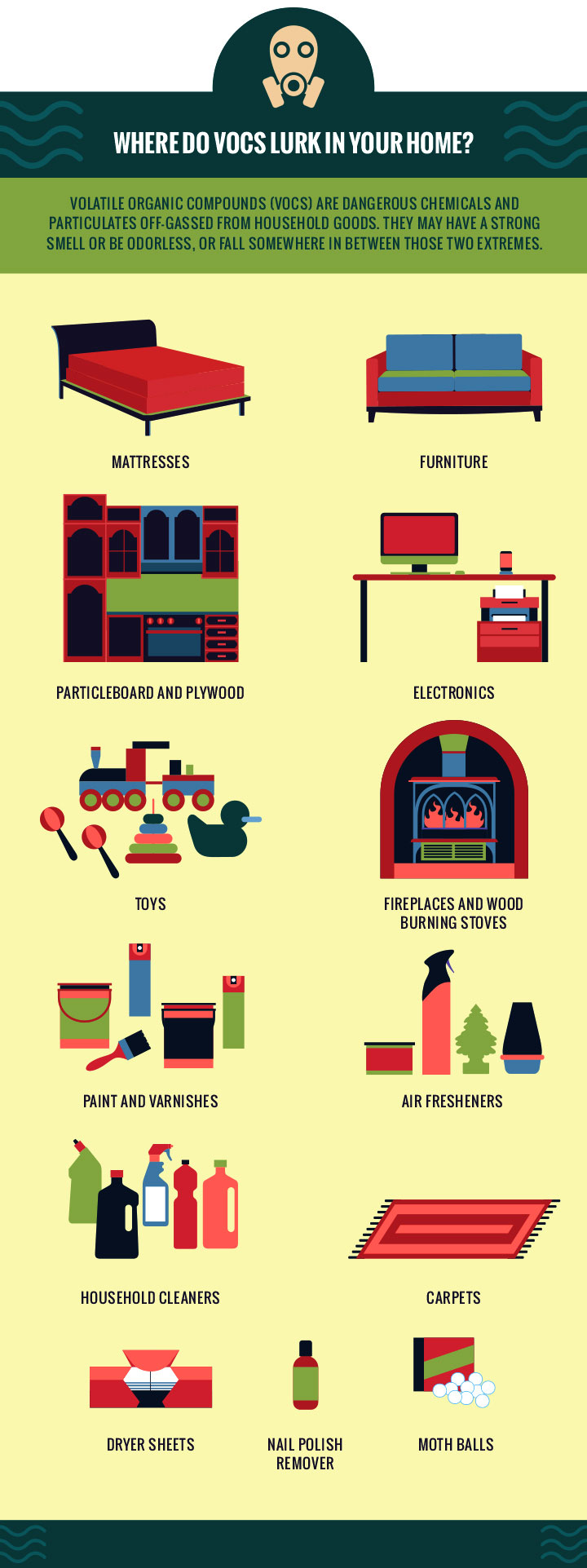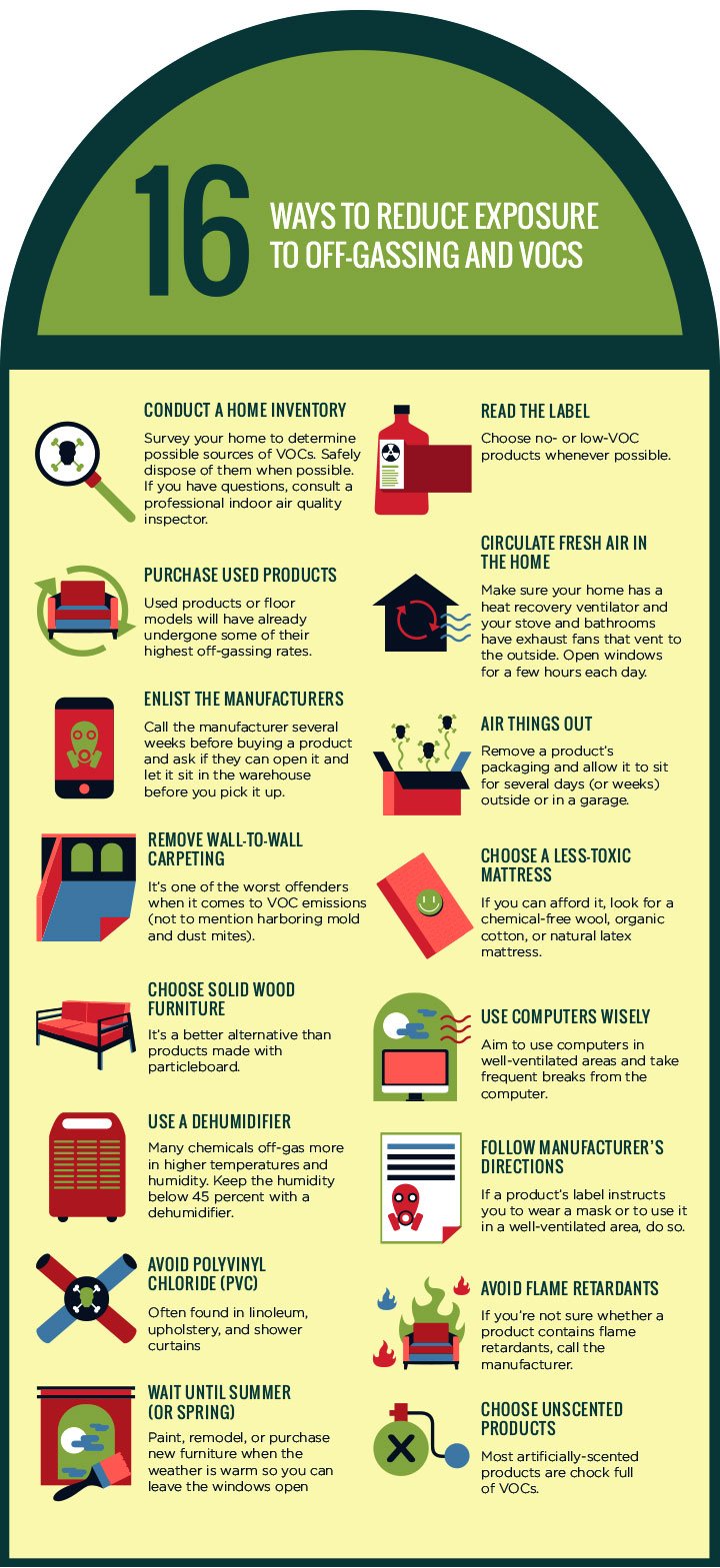Maybe you’ve heard of off-gassing, with headlines claiming a mattress or couch slowly ruined someone’s health. Maybe you shrugged it off. Who has time to worry about their couch? Maybe off-gassing just hasn’t made it into your dinner table conversation yet. In any case, it’s time to pay attention.
When it comes to the chemicals used to manufacture common household goods, there’s a whole lot we don’t know. These chemicals don’t just stay in products. Many of them enter the air via a process called off-gassing; they are then ingested by the people and animals who use them. Thus far, these chemical contaminants have been linked to around 180 human diseases and health conditions.
But don’t sell your house just yet. A little education—understanding what products contain harmful chemicals and how to reduce your exposure—is a powerful thing. It can help you make your home a healthier place for years to come. Read on for the low-down.
What is Off-Gassing?
Off-gassing (also known as out-gassing) refers to the release of airborne particulates or chemicals—dubbed volatile organic compounds (VOCs)—from common household products. Potential sources of off-gassing range from construction materials to carpeting, cabinetry, furniture, paint, and any number of household goods. Some of the most common chemicals off-gassed from household items include formaldehyde, benzene, ammonia, and toluene. While off-gassing can be easily identified by so-called “new car” and “new carpet” smells, it can also be odorless.
Sound scary? Unfortunately, we’re just getting started. More than 80,000 chemicals have been introduced into the environment in the last 50 years, and the majority of them haven’t been studied for their effects on people or animals. But that hasn’t stopped manufacturers from incorporating these chemicals into their production processes.
While the effects of off-gassing are still being studied, what we do know is that many of the chemicals can cause allergic reactions and other health problems—including congestion, coughing, skin irritation, asthma attacks, and fatigue, as well as leukemia, lymphomas, or cognitive decline. Health effects depend on the particular chemical(s) involved, the concentration of VOCs in the home, and how long and how often a person is exposed.
Look around your home: You’re all but guaranteed to find any number of VOC-emitting items. Some of the most common sources of off-gassing include:
Furniture: Mattresses, couches, chairs, and other furniture are all common sources of VOCs.
Carpets: That “new carpet smell” is not a good thing. Carpets can emit VOCs for five or more years (though off-gassing decreases after the first few months).
Electronics: Computers and their keyboards are common off-gassers. During the printing process, laser printers and photocopiers can release ozone, which can irritate the nose, lungs, and throat.
Particleboard and plywood: These materials are present in virtually any home, whether in construction materials or furniture. Unfortunately, the glue that holds them together almost always contains formaldehyde, a known carcinogen.
Household cleaners: Despite containing an enormous number of toxic contaminants and VOCs, the majority of cleaning products are not assessed for safety. Soaps, glass cleaners, toilet bowl cleaners, polishes, and detergents are all common sources of VOCs.
Dryer sheets: They may smell nice, but these sheets off-gas a whole host of chemicals. In fact, the Material Safety Data Sheet warns against dryer sheets, citing them as a cause of eye and skin irritation.
Nail polish remover: Your average bottle of nail polish remover likely contains acetone, a nasty and harmful chemical. Breathing acetone can cause issues ranging from irritation of the nose, throat, lungs, or eyes to headaches, nausea, and fatigue.
Other household goods: Toys, tennis balls, paints, wallpaper, adhesives, cabinetry, bedding, cars, varnishes, floor coverings, fireplaces, wood burning stoves, vinyl, plastics, cosmetics, air fresheners, moth balls, and newspapers all frequently off-gas harmful chemicals.
How to Reduce Exposure
While it can certainly take time and effort (and maybe some extra money), there are ways to limit your exposure to VOCs in the home.
Conduct a home inventory. Survey your own home to determine possible sources of VOCs. Whenever possible, safely dispose of them: Contact your local government or visit the Household Hazardous Waste (HHW) web site to learn how. If you have questions, consult a professional indoor air quality inspector.
Read the label. Choose no- or low-VOC products whenever possible. If a product isn’t clearly labeled, call the manufacturer. Check new furniture to see if any of the components are certified by GREENGUARD, Scientific Certification Systems, or SGS Group, three organizations that approve sustainable and low- or no-emitting products.
Purchase used products. Whether it’s an older home or a used couch, used products will have already undergone some of their highest off-gassing rates. If you can’t find a used product, try to purchase a floor model, which will have had some time to air out while outside of its packaging.
Circulate fresh air into the home. If possible, make sure your home has a heat recovery ventilator, your stove has an exhaust fan that vents to the outside, and every bathroom is equipped with a well-functioning exhaust fan. Another easy way to introduce fresh air? Open the windows for a few hours each day.
Enlist the manufacturer’s help. If you’re planning to purchase a product that’s likely to off-gas, call the manufacturer several weeks in advance and ask if it would be possible for them to open the product and allow it to sit in the warehouse (ideally in fresh air). Oftentimes, the worst of the off-gassing occurs in the first few days after a product has been opened.
Air things out. Whenever possible, remove the packaging of a new product and allow it to sit for several days (or even weeks) outside or in a garage.
Remove wall-to-wall carpeting. It’s one of the worst offenders when it comes to VOC emissions (not to mention it harbors mold and dust mites). Can’t give up carpet completely? Replace the wall-to-wall stuff with area rugs. If throw rugs don’t cut it, replace traditional wall-to-wall carpet with a natural fiber carpet such as wool. Ideally, choose carpeting that doesn’t use adhesives.
Choose a less-toxic mattress. If you can afford it, look for a chemical-free wool, organic cotton, or natural latex mattress. Choose an organic cotton or wool futon if you’re looking for a more budget-friendly option. At the very least, choose a used mattress, which will off-gas less than a new model. Also search for mattresses that are PBDE-free, and avoid versions made with polyurethane foam.
Choose solid wood furniture. It’s a better alternative than products made with particleboard. Your best option is to choose FSC- or SFI-certified products, which are required to meet certain standards for health and sustainability. In general, try to avoid furniture made with cheap plywood, and choose products that utilize non-toxic, water-based glues.
Use computers wisely. Aim to use computers in well-ventilated areas, and take frequent breaks away from the computer (ideally in fresh, outdoor air).
Use a dehumidifier. Many chemicals off-gas at greater rates in higher temperatures and humidity. Keep the humidity below 45 percent to help limit these emissions.
Follow manufacturer’s directions. For example, if a product’s label instructs you to wear a mask or to use it in a well-ventilated area, do so. Those warnings are there for a reason, and following usage directions can help reduce your exposure to harmful chemicals.
Avoid polyvinyl chloride (PVC). Often found in linoleum, upholstery, and shower curtains, there’s pretty much nothing redeemable about the health properties of this product. It’s one of the most commonly used plastics, so eliminating it from your home can be tough, but the effort is worth it if you’re looking to cut back on negative health effects.
Avoid flame retardants. This can be difficult feat when it comes to furniture (particularly couches and mattresses), but your health will be better. If you’re not sure whether a product contains flame retardants, call the manufacturer.
Choose unscented products. Most artificially scented products are full of VOCs. Whenever possible, opt for unscented versions.
Wait until summer (or spring). Paint, remodel, or purchase new furniture when the weather is warm. That way, you can leave the windows open.
We admit it: Reducing exposure to off-gassing and VOCs can be daunting. But the incentive is huge. By taking the time and energy to limit VOC emissions in your home, you’ll be investing in your health for years to come.
If this article has you interested in greening your home furnishings, check out these pieces of craft furniture— http://www.custommade.com/gallery/custom-arts-and-crafts/








